How Eremenko could not surround and destroy the "scoundrel Goth"
The actions of the Southern Front to capture Rostov and Bataysk and intercept the escape routes of the North Caucasian Wehrmacht grouping to the east did not lead to the desired result. Manstein, maneuvering and inflicting short but strong counterattacks, withstood.
Defeat the "scoundrel Goth"
Along the Seversky Donets, at the junction of two German army groups, it was advancing (How Manstein Saved the German Army from Disaster in Early 1943) aimed at Mines 5th shock army of General Tsvetaev (3 divisions).
In the triangle of the Don, Kuberle and Manych rivers, the heavily weakened German 4th Panzer Army of Goth fought back. The 57th Panzer Corps (23rd and 17th Panzer, 16th Motorized Divisions) was bled dry by previous battles. Romanian troops existed more on paper than in reality. The remaining units were completely demoralized. Only the SS Viking motorized division, transferred from the Caucasus, was combat-ready. Herman Goth needed to prevent the Russians from breaking through to Rostov along the lower reaches of the Don on his left flank, on his right flank - to ensure communication with the 1st Panzer Army.
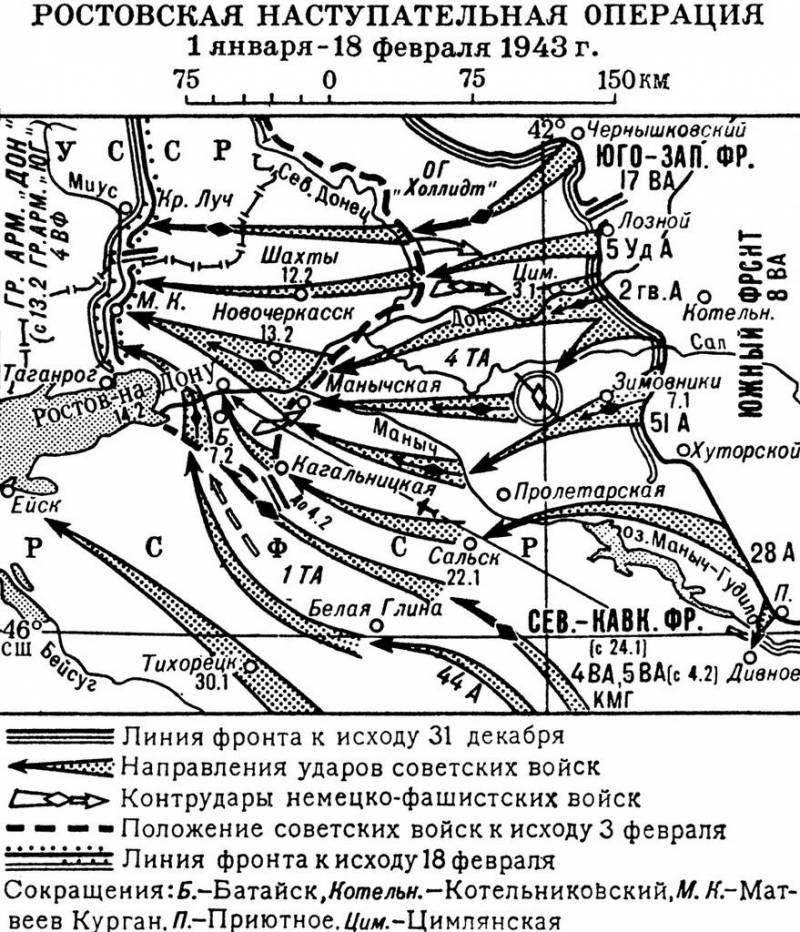
The commander of the Southern Front (SF) Eremenko, having 15 divisions, 10 brigades in this direction, a multiple advantage in tanks, was full of optimism and was going to quickly defeat the "scoundrel Goth".
The 2nd Guards Army of General Malinovsky was aimed at the villages of Tsimlyanskaya and Konstantinovskaya, with a further turn to the south. At the forefront of the army's two strike groups were Sviridov's 2nd Guards Mechanized Corps and Rotmistrov's 3rd Guards Tank Corps. Trufanov's 51st Army (4 divisions and a tank brigade) was advancing on the southern wing of the Southern Front in cooperation with Gerasimenko's 28th Army (2 divisions, 8 brigades, including tank and mechanized). Two armies, advancing along both banks of the Manych, had to create a cauldron.
On January 3, 1943, brigades of the 2nd Guards Mechanized Corps captured Tsimlyanskaya, threatening the rear of the German Hollidt group. General Hollidt began to withdraw his right flank to the Kagalnik River. On January 6, Rotmistrov's advanced tanks broke into the village of Semikarakorskaya, seized a bridgehead on the northern bank of the Don, and fought with the main forces for the village of Konstantinovskaya. On January 7, after a 5-day stubborn battle, the troops of the 51st Army occupied a stronghold and the Zimovniki railway station.
The 6th mechanized corps of General Bogdanov, which knocked out parts of the Viking division, became known as the 5th Guards Zimovnikovsky. True, the corps suffered heavy losses. But in the second echelon there were also the 4th and 3rd Guards Mechanized Corps.
Troops of the 28th Army reached Stepnoy. The advanced Soviet detachments went to the distant approaches to Novocherkassk, where the headquarters of the Don group was located. Manstein had to move to Taganrog.
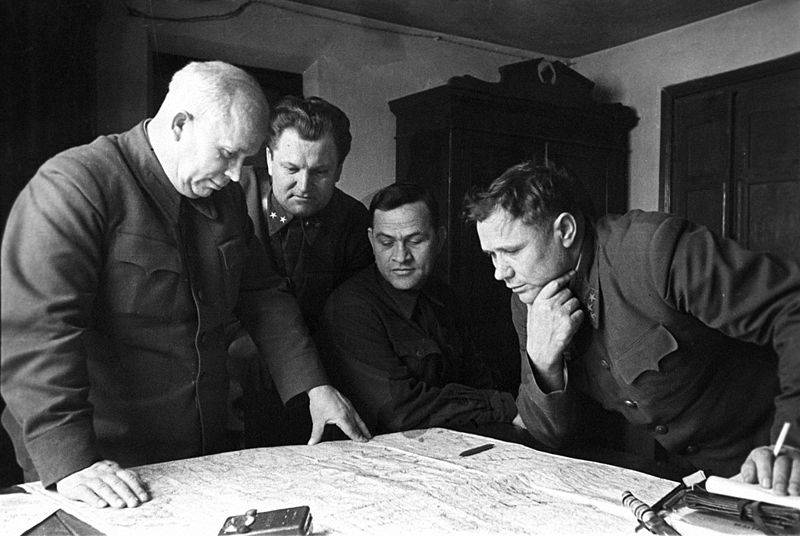
Members of the Military Council of the Stalingrad Front: Khrushchev, Kirichenko, Chuyanov and Eremenko's Commander, December 1942
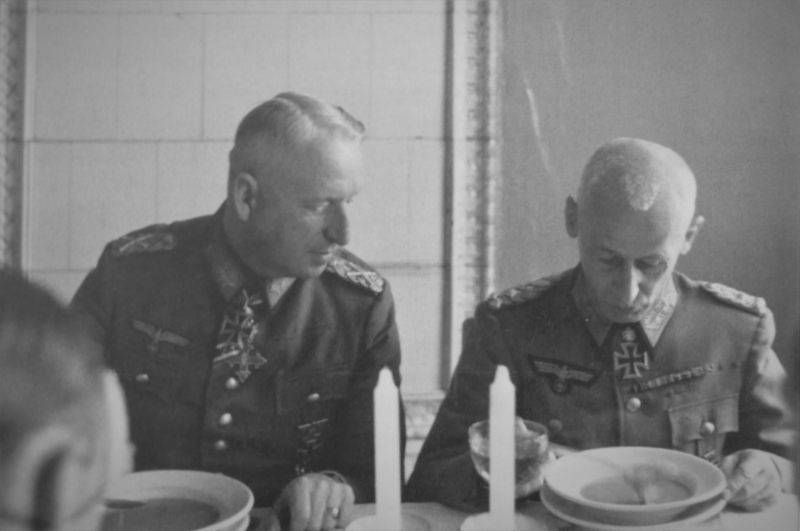
Field Marshal Erich von Manstein and Colonel General Hermann Goth at the dinner table. 1942
The Germans successfully fight back
On January 5, 1943, Eremenko's troops received specified tasks. The 5th shock army and the Kreizer group from the 2nd Guards Army were supposed to reach the Seversky Donets by the end of January 7 and begin the crossing. 3rd Guards Tank Corps with two rifle divisions - to occupy the crossings at Bagaevskaya on the Don and at the Vesyoliy farm on Manych. The 51st Army and the 3rd Guards Mechanized Corps were to capture Proletarskaya and Budyonnovskaya.
However, the Nazis skillfully and brutally fought, did not allow themselves to be surrounded. On January 9, General Hollidt, having transferred the 11th Panzer Division to his right flank, launched a counterattack on Tsvetaev's 5th Shock Army and the Kreizer group. Our troops were forced to go on the defensive. The command of the Law Firm even requested assistance from the neighboring 5th Panzer Army.
For the next 5 days, the northern wing of the YuF repelled enemy attacks. The center and the southern flank moved very slowly, 2-3 km per day.
On January 14-15, the villages of Bataevskaya, Atamanskaya and Orlovskaya were liberated. On January 17, the troops of the YuF reached the eastern bank of the Seversky Donets River and the northern bank of the river and the Manych Canal. Here the Germans again well fortified. The German 57th Panzer Corps of Kirchner fought east of Proletarskaya. Here the 503rd heavy tank battalion, armed with Tiger tanks, entered the battle.
Thus, the Soviet offensive on Rostov finally stalled. The Germans furiously and skillfully fought back, counterattacked. Soviet strike formations were bled dry. In the troops remote from their bases, there was an acute crisis with the availability of ammunition and fuel.
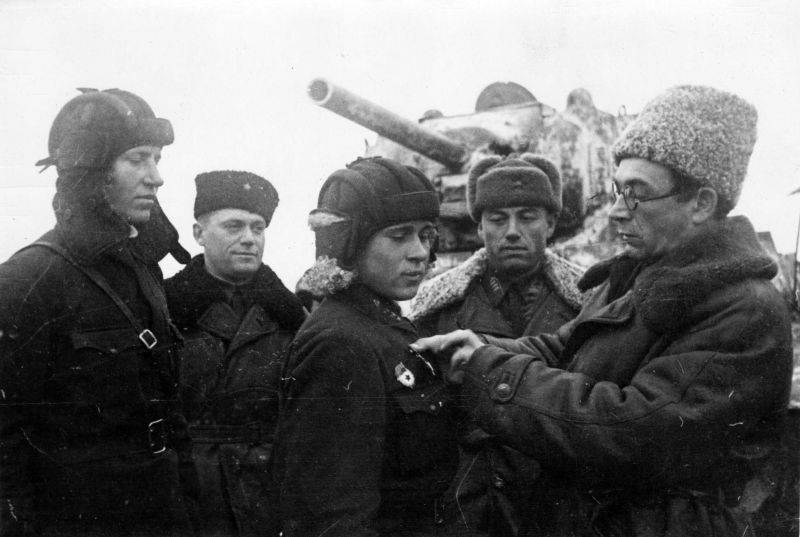
General P. A. Rotmistrov presents a government award to Senior Lieutenant Bogatyrev. December 29, 1942
Battle for Bataysk and Manychskaya
The command of the Law Firm, in order to turn the tide and break through to Rostov, forms two shock mechanized groups. The first - in the band of the 1st Guards Army, consisted of Rotmistrov's 3rd Guards Tank Corps, the 2nd and 5th Mechanized Corps and the 88th Rifle Division. The 51st Army was attached to the 3rd and 4th Guards Mechanized Corps, which were aimed at Azov.
On January 19, 1943, the Rotmistrov group launched an offensive. The guards crossed the Manych River in the area where it flows into the Don, and liberated the Manychskaya station. The advance detachment of Colonel Yegorov (eight T-34 tanks, 3 T-70 tanks, five armored vehicles, nine armored personnel carriers and 200 fighters) broke through to Bataysk at dawn on January 20, intercepting the railway south of the city. The main forces of the shock group were supposed to follow Yegorov's detachment, but it was not possible to consolidate the first success.
Bataisk could not be taken on the move. The Germans counterattacked, forced the Yegorov detachment, which lost 7 tanks, to take up defense in the area of the Lenin state farm and the OGPU village. On the left wing of the Rotmistrov group, a sudden blow was delivered by part of the 16th German Motorized Division. Soviet troops got stuck near the village of Manychskaya. The German command won a day to transfer additional forces to a dangerous area.
On the left flank, the troops of the 51st Army took Proletarskaya and crossed Manych. The forward detachments of the 28th Army joined with the 30th Division of the 5th Cavalry Corps of the Transcaucasian Front. By January 22, Salsk was liberated. On the same day, the 11th German Panzer Division crossed the Don near Rostov. Along the southern bank of the Manych, units of the 16th motorized division with the 116th tank battalion and the Tiger company went up to the mouth.
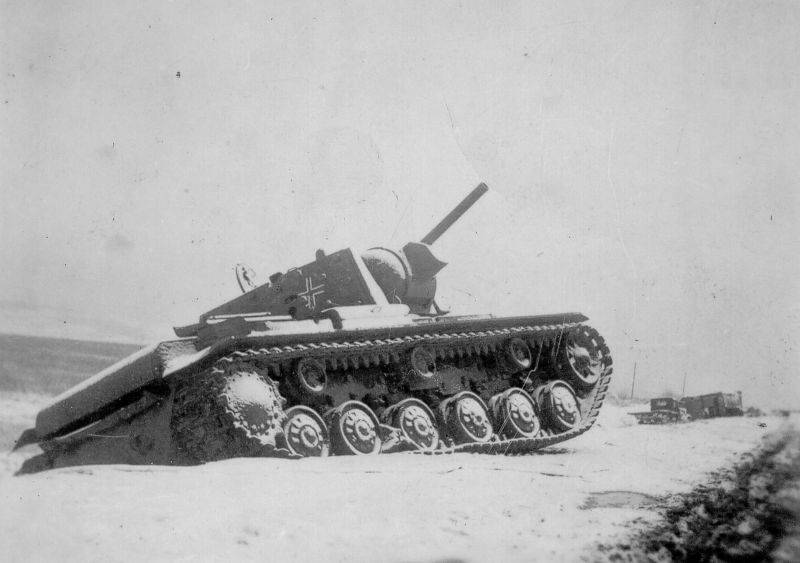
Wehrmacht tank KV-1, abandoned on the side of a snowy road. The captured KV-1s were designated Panzerkampfwagen KV-IA 753(r) by the Germans. January 1943
Rotmistrov, fearing the destruction of his avant-garde, ordered Yegorov to break back. The command of the Law Firm did not agree with this decision and ordered to continue the offensive. On the morning of January 23, Eremenko ordered the 2nd Guards Army to urgently take the positions left by Rotmistrov's units and intercept the railway south of Bataysk, take measures to liberate Bataysk.
However, on January 23, the German 11th Panzer Division, with the support of the 16th Motorized Division, counterattacked the Soviet units preparing for the offensive. Our troops were driven back to the bridgehead at Manychskaya. On January 24, the Germans attacked Manychskaya, but unsuccessfully. On the 25th, the Nazis attacked again, carried out a false attack in another sector, distracting the Russians, and drove us out of the Manych bridgehead.
On January 26, Rotmistrov reported to the command of the 2nd Guards Army that 5 tanks and 7 anti-tank guns remained in the 7th Guards Corps, all brigade commanders were killed or wounded, the number of fighters was reduced to 2. Only 200 tanks remained in the 2nd Guards Mechanized Corps , in the 8rd tank - 3 tanks. As a result, Rotmistrov's group lost its combat capability.
The maneuvering tactics of the Wehrmacht brought success. The commander of the "fire" 11th Panzer Division, General Balk wrote:
A major role in the successes of the Germans was played by better command and control of troops and communications, mainly by radio.
The German general noted that in the battles on the Chir River, the Russian command abandoned the corps of the 5th Panzer Army, without coordinating their actions in time, without organizing interaction with numerous infantry. As a result, the 11th Panzer Division was able to strike alternately: first on one, then on the other corps.
In the end, the strike power of the Russian tank army was weakened to such an extent that the 11th division was able to withdraw and begin to operate against another Russian tank formation.
All further actions of the Law Firm to seize Rostov and Bataysk and intercept the escape routes of the North Caucasian Wehrmacht grouping to the east did not lead to the desired result. Manstein, maneuvering and inflicting short but strong counterattacks, withstood.
In January 1943, Eremenko's armies advanced 150-200 km, but they could not cut the Rostov "throat". Also, the Transcaucasian Front was unable to tie down the German 1st Panzer Army in battle. The Germans successfully avoided the Caucasian pocket.
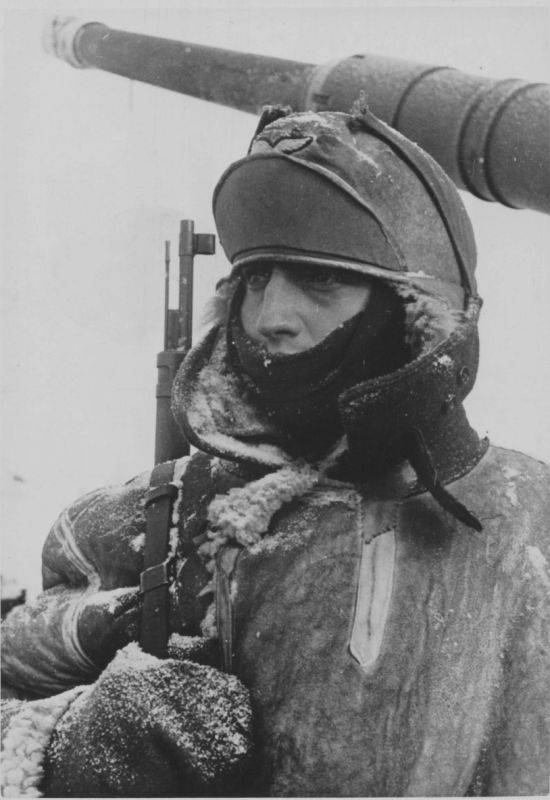
German sentry near the 88-mm anti-aircraft gun in the Don River area. January 1943
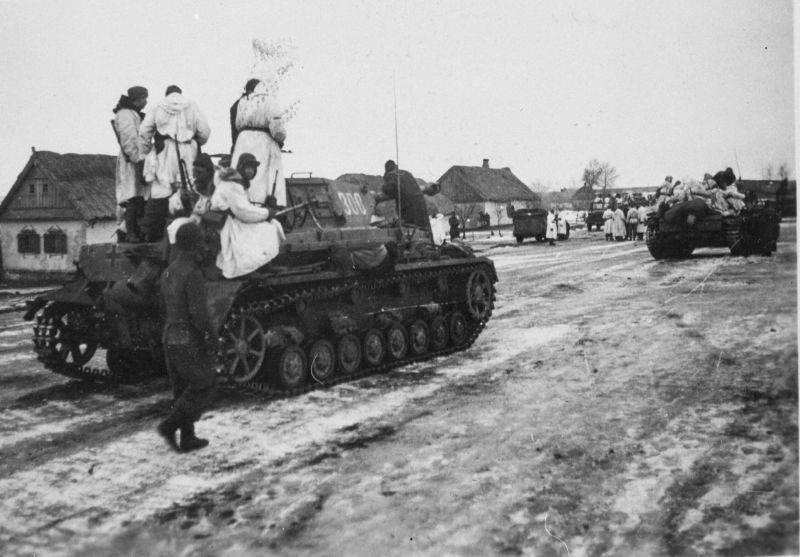
Information